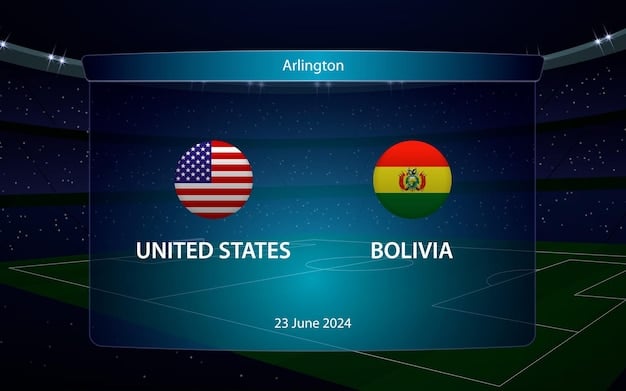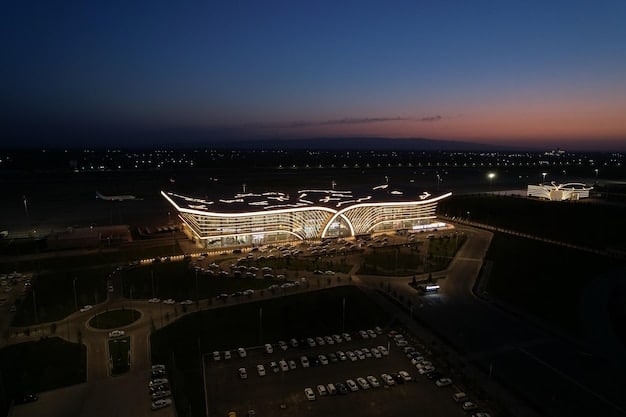World Cup 2026: Schedule, Key Dates & Fan Guide for the US

The 2026 FIFA World Cup, co-hosted by the US, Canada, and Mexico, features an expanded 48-team format and an unprecedented 104 matches, with key dates and venues crucial for US fans planning to experience this historic event.
As the countdown begins for the World Cup 2026: Understanding the Tournament Schedule and Key Dates for US Fans, anticipation builds for what promises to be the largest and most inclusive FIFA World Cup in history. Scheduled to span three nations—the United States, Canada, and Mexico—this expanded tournament will redefine football’s global spectacle. With an increased number of teams and matches, navigating the complexities of the schedule, understanding ticket opportunities, and preparing for the ultimate fan experience will be paramount for supporters across the US.
Unpacking the Expanded World Cup 2026 Format
The 2026 FIFA World Cup marks a significant departure from previous editions. For the first time, 48 nations will compete, a substantial increase from the 32-team format that has been in place since 1998. This expansion is designed to make the tournament more inclusive, offering more countries the chance to participate on the global stage. The direct consequence is a dramatically increased number of matches, soaring from 64 to an astonishing 104 games. This presents both exciting opportunities and logistical challenges for organizers and fans alike.
The new format will see teams divided into 12 groups of four, with the top two from each group, along with the eight best third-place teams, advancing to a round of 32. This structure aims to retain the drama of the group stage while ensuring more competitive matches in the knockout rounds. The extended tournament duration, necessitated by the increased number of games, also means a longer period of immersive football action.
The Shift to 48 Teams and Its Implications
The decision to expand to 48 teams has been a topic of much discussion. Critics have raised concerns about the potential dilution of quality and the increased burden on host nations. However, proponents argue that it democratizes the sport, providing a pathway for emerging football nations to gain invaluable experience and exposure. From a fan perspective, it means more teams to follow, more diverse styles of play, and potentially more underdog stories to cheer for.
- Increased global representation and diversity in the tournament.
- More competitive matches in the early stages as teams fight for qualification.
- Greater opportunity for emerging football nations to shine.
- Extended tournament duration, offering a longer period of engaging football.
The expanded format also impacts the qualification process. With more slots available for each confederation, the journey to the World Cup becomes slightly less arduous for some nations, while for others, it solidifies their place as regulars. For US fans, this means a wider array of teams to learn about and support, enhancing the overall viewing experience.
Three Nations, One Tournament: A Unique Hosting Model
The 2026 World Cup is unprecedented in its multi-nation hosting model, with the United States, Canada, and Mexico sharing duties. While previous tournaments have had joint hosts, this marks the first time three countries will collaborate. The vast geographical spread across North America adds another layer of complexity but also promises a truly continental celebration of football.
- The United States will host the majority of matches, including all games from the quarterfinals onward.
- Canada and Mexico will host a significant portion of group stage and early knockout matches.
- This shared responsibility aims to leverage existing infrastructure across multiple major cities.
- It promises a unique cultural experience for visiting fans across diverse locales.
This tri-nation approach is designed to minimize the financial and infrastructural burden on any single country, utilizing existing, world-class stadiums and transportation networks. For fans in the US, it means a substantial number of matches will be played on home soil, reducing travel barriers and making the event more accessible than ever before. Understanding the distribution of matches across the host cities becomes crucial for planning attendance.
Key Dates and Phases: Plotting the World Cup 2026 Journey
Understanding the key dates and phases of the 2026 World Cup is essential for fans eager to plan their experience. The tournament’s extended duration means a longer window for football action, from the opening ceremony to the final whistle. While specific match schedules are still being finalized, the general timeline provides a clear roadmap for what to expect and when.
The FIFA World Cup 2026 is set to kick off in mid-June and conclude in mid-July. This roughly month-long period will be packed with daily matches across various venues. For US fans, this means balancing the excitement of the tournament with their daily routines, making careful planning of viewing parties, travel, and ticket pursuits a necessity.
Opening Ceremony and Group Stage
The grand opening ceremony is a spectacle in itself, marking the official start of the tournament. The first match, often featuring the host nation, is a highly anticipated event. Following this, the group stage will unfold over approximately two weeks, with multiple matches played daily. This phase is characterized by intense competition as teams vie for a spot in the knockout rounds. Each of the 12 groups will play their matches across a set number of venues, ensuring a dynamic flow of games.
During the group stage, teams will play three matches each. The staggered kick-off times will allow fans to watch multiple games in a single day, a delight for dedicated supporters. This phase is crucial for establishing team narratives and identifying potential dark horses or early favorites. For those traveling, understanding which cities host which groups will be key to planning shorter, more focused trips.
Knockout Rounds: The Road to the Final
Once the group stage concludes, the tournament shifts into the high-stakes knockout rounds. This phase begins with the Round of 32, a new addition to the expanded format, followed by the Round of 16, Quarter-Finals, Semi-Finals, and finally, the World Cup Final. Each match in this stage is a do-or-die encounter, promising unparalleled drama and excitement.
The United States will host all matches from the Quarter-Finals onward, including the Semi-Finals and the grand Final. This concentration of critical games in the US ensures that the climax of the tournament will be played out on American soil, offering US fans a unique opportunity to witness history unfold. The schedule for these knockout matches will be particularly important for fans hoping to attend the most pivotal games.
- Round of 32: Marks the start of single-elimination play.
- Round of 16: Further narrows the field to the best teams.
- Quarter-Finals: Elite eight teams compete for a semi-final spot (all in US).
- Semi-Finals: The penultimate stage before the final match (all in US).
- Third-Place Play-off: Determines the bronze medalists.
- Final: The ultimate showdown to crown the World Champion (in US).
The progression of the tournament moves swiftly through these stages, with minimal rest days between matches in the knockout rounds to maintain momentum. This intense period of play makes strategic viewing and attendance planning vital for those looking to immerse themselves fully in the World Cup experience.
US Host Cities and Venues: Where the Action Unfolds
The United States is set to be the primary host for the 2026 World Cup, with 11 cities across the nation selected to welcome teams and fans. These venues, spanning from coast to coast, represent a diverse cross-section of American culture and geography. Understanding where the matches will be played is crucial for US fans planning to attend games or simply immerse themselves in the local World Cup atmosphere.
Each host city boasts world-class stadiums capable of accommodating the massive crowds expected for World Cup matches. These venues are not just sports arenas but are often hubs of local pride and community, promising a vibrant backdrop for the tournament. The geographical spread also allows for easier access for fans in different regions of the country, minimizing extensive travel for many.
East Coast Venues: Northeastern Hubs
The East Coast offers several major metropolitan areas that will serve as World Cup hosts, providing convenient access for fans in the densely populated northeastern US. These cities are known for their rich history, diverse populations, and enthusiastic sports cultures, making them ideal backdrops for international football matches. The selected venues are large, modern stadiums, ready to host thousands of screaming fans.
- Boston (Gillette Stadium): Located just outside the city, known for its passionate sports fan base.
- New York/New Jersey (MetLife Stadium): A colossal venue with strong transport links to one of the world’s largest cities.
- Philadelphia (Lincoln Financial Field): Nestled in a city with deep historical roots and a vibrant sporting scene.
- Miami (Hard Rock Stadium): A global crossroads city known for its energetic atmosphere and diverse culture.
- Atlanta (Mercedes-Benz Stadium): A modern architectural marvel in a rapidly growing, football-loving city.
These East Coast venues are strategically placed to capture a broad audience, offering a mix of established football communities and burgeoning fan bases. Their accessibility via major airports and public transportation networks will be a key factor for visiting fans, as well as for local supporters looking to attend multiple games within a reasonable travel radius.
Central and Southern US Venues: Spanning the Heartland
Moving inland and to the south, several cities in the central and southern United States will also host World Cup matches. This spread ensures that the excitement of the tournament reaches different corners of the country, engaging a wider audience. These venues reflect the diverse landscapes and traditions of America, from the warm climates of the south to the vast plains of the Midwest.
- Dallas (AT&T Stadium): A massive, state-of-the-art stadium in a state exceptionally passionate about sports.
- Houston (NRG Stadium): A large, modern venue in a city known for its diverse population and energy.
- Kansas City (Arrowhead Stadium): A city with a deep sporting heritage and a centrally located venue.
The selection of these cities highlights FIFA’s commitment to making the World Cup accessible across different regions of the US. Each of these venues offers unique local attractions and hospitality, providing fans with a memorable experience beyond the matches themselves. The ease of access for local residents will undoubtedly contribute to sell-out crowds and electric atmospheres.
West Coast Venues: Pacific Excitement
The West Coast will play a significant role in the 2026 World Cup, offering matches in some of the most iconic cities in the region. These venues provide stunning backdrops and attract a different demographic of fans, known for their vibrant and innovative cultures. The sunset views from these stadiums promise a truly picturesque tournament experience.
- Seattle (Lumen Field): A true soccer city with a fervent fan base that consistently fills its stadium.
- San Francisco Bay Area (Levi’s Stadium): Located in the heart of Silicon Valley, a tech-forward region with a global outlook.
- Los Angeles (SoFi Stadium): A newly built, cutting-edge stadium in one of the world’s largest entertainment capitals, a strong contender for the final match.

The West Coast venues are strategically important for drawing in fans from the Pacific Rim and offer a unique blend of urban sophistication and natural beauty. The existing strong soccer cultures in cities like Seattle and Los Angeles ensure passionate crowd support. The distribution of matches across these diverse locales in the US underscores the truly national scale of the upcoming World Cup.
Ticketing and Accommodation: Planning Your World Cup Experience
Attending the World Cup is a dream for many, but realizing that dream requires meticulous planning, especially concerning ticketing and accommodation. With the tournament being hosted across multiple cities in the US, understanding the process for acquiring tickets and securing places to stay will be critical for an enjoyable and stress-free experience. Early preparation is key to navigating the high demand and ensuring you don’t miss out.
FIFA typically manages ticketing centrally, with various sales phases available to the public. These phases often include pre-sales for specific cardholders, a lottery system for general public applications, and last-minute sales. Accommodation, on the other hand, will be handled through traditional booking channels, but with significantly inflated prices and limited availability as the tournament approaches.
Navigating World Cup Ticket Sales
Securing tickets for the World Cup is a competitive process. FIFA generally opens ticket applications in phases, often starting a year or more before the tournament begins. The most common method involves a lottery system, where fans register their interest for specific matches, teams, or venue packages. Being aware of these application windows and having a clear strategy is crucial.
- Registration for Information: Sign up for official FIFA World Cup newsletters to receive updates on ticket sales.
- Application Phases: Understand the different stages of ticket sales, which may include random selection draws and first-come, first-served sales.
- Ticket Packages: Consider packages that include multiple matches, especially if you plan to follow a specific team or stay in one host city.
- Resale Platforms: Be cautious of unofficial resale platforms; only use official FIFA resale channels if available, to avoid scams.
Prices for World Cup tickets vary significantly based on the match stage, seating category, and the teams involved. Group stage matches are generally more affordable than knockout rounds, and the final is typically the most expensive ticket. Budgeting for tickets well in advance, and being flexible with your match selections, can increase your chances of success. It’s also wise to consider the logistics of traveling between venues if you plan to attend multiple games in different cities.
Accommodation Strategies for Host Cities
Once you have a handle on potential match dates and locations, booking accommodation becomes the next priority. Hotels, short-term rentals, and other lodging options in host cities will experience peak demand and significantly higher prices during the World Cup. Proactive booking and considering alternative options can save both money and stress.
- Book Early: Prices will only increase and availability will decrease as the tournament approaches. Aim to book as soon as your match attendance plans are firm.
- Consider Areas Outside City Centers: Hotels slightly outside the immediate downtown area or stadium vicinity might offer better value, provided there are good transport links.
- Explore Alternative Lodging: Look into vacation rentals, hostels, or even staying with friends and family if possible.
- Public Transportation: Familiarize yourself with public transport options in your chosen host cities to commute to stadiums efficiently.
- Flexibility: If your team’s schedule or your travel plans change, having flexible booking options, if available, can be beneficial.
Understanding the local transportation network in each host city is also vital. Many stadiums are located outside central business districts, requiring efficient public transport or rideshare services. Planning your accommodation and transport concurrently will help streamline your World Cup experience and prevent last-minute logistical headaches. The cost of accommodation during such a major event can easily surpass ticket costs, making this element a critical component of your overall budget.
Fan Zones and Local Activities: Beyond the Stadium
The World Cup experience extends far beyond the 90 minutes on the pitch. Host cities transform into vibrant hubs of celebration, offering a plethora of fan zones, cultural events, and local activities. For US fans, these peripheral experiences provide an opportunity to immerse themselves fully in the tournament atmosphere, even if they don’t have tickets to every match. These areas foster a sense of global community, bringing together supporters from all corners of the world.
Fan zones, typically large outdoor areas, feature giant screens broadcasting live matches, food and beverage vendors, merchandise stalls, and entertainment. They are family-friendly environments designed to capture the festive spirit of the World Cup. Beyond these official zones, local businesses, bars, and cultural institutions often host their own themed events, contributing to a city-wide celebration.
Official FIFA Fan Zones
FIFA Fan Zones are a staple of every World Cup, providing a safe and exciting public space for fans to gather. In 2026, each US host city is expected to establish at least one major fan zone. These zones offer a communal viewing experience, allowing thousands of fans to watch matches together, creating an electrifying atmosphere similar to being inside the stadium.
- Live Match Broadcasts: Giant screens ensure optimal viewing of all World Cup matches.
- Food and Beverage: A wide selection of local and international food and drink options.
- Entertainment: Live music, cultural performances, and interactive games.
- Merchandise: Official World Cup and team merchandise available for purchase.
- Family-Friendly: Often include activities for children and designated family areas.

These fan zones serve as vital gathering points, particularly for those who couldn’t secure match tickets or simply prefer a more relaxed, communal viewing experience. They are designed to encapsulate the global appeal of football and offer a taste of the World Cup festive spirit to a broader audience. Checking the schedule and locations of these official fan zones will be essential for planning your time in each host city.
Local Festivals and Cultural Events
Beyond the official fan zones, host cities often leverage the World Cup to showcase their unique culture and offer additional entertainment. Local businesses, community groups, and tourism boards organize a variety of events, from street festivals and food markets to art exhibitions and live concerts. These activities provide a deeper dive into the local flavor of each city and enhance the overall visitor experience.
- Restaurant and Bar Promos: Many establishments will offer special menus and viewing parties.
- Cultural Exhibitions: Museums and galleries may feature football-themed or international exhibits.
- Community Events: Parades, block parties, or youth football tournaments could be organized.
- Public Viewings: In addition to official zones, other public spaces might set up screens for local viewing.
Engaging with these local activities allows fans to experience the World Cup as part of the broader celebration within American communities. It’s an opportunity to connect with local fans, experience regional hospitality, and discover what makes each host city unique. Checking local tourism websites and event listings closer to the tournament will provide the most up-to-date information on these vibrant cultural offerings.
| Key Aspect | Brief Description |
|---|---|
| ⚽ Format Expansion | Expanded to 48 teams, 104 matches, 12 groups of 4, with a new Round of 32. |
| 🗓️ Key Dates | Mid-June to mid-July 2026; US hosts all matches from Quarter-Finals onwards. |
| 🏙️ US Host Cities | 11 cities including NY/NJ, LA, Dallas, Miami, Seattle, Atlanta, Boston, etc. |
| 🎟️ Fan Experience | Official FIFA Fan Zones, local cultural events, and accommodation planning are key. |
Frequently Asked Questions about World Cup 2026
▼
The 2026 FIFA World Cup will feature an expanded format with 48 national teams, a significant increase from the previous 32-team setup. This expansion leads to a total of 104 matches played throughout the tournament, spread across the host nations of the United States, Canada, and Mexico. This updated structure aims to offer greater global participation and more competitive fixtures.
▼
The 2026 FIFA World Cup will be uniquely co-hosted by three North American countries: the United States, Canada, and Mexico. This marks the first time in World Cup history that the tournament will be jointly hosted by three nations. The United States will host the majority of the matches, including all games from the quarter-finals onwards.
▼
The 2026 World Cup is scheduled to commence in mid-June and conclude in mid-July 2026. The tournament phases include an extended group stage with 12 groups of four teams, followed by knockout rounds starting with a new Round of 32. Key stages like the Quarter-Finals, Semi-Finals, and the Final will all be hosted within the United States.
▼
A total of 11 cities across the United States have been selected as host venues for the 2026 World Cup. These include major metropolitan areas such as New York/New Jersey, Los Angeles, Dallas, Miami, Seattle, Atlanta, Boston, Philadelphia, Houston, Kansas City, and San Francisco Bay Area. These cities boast state-of-the-art stadiums capable of hosting large crowds.
▼
Official ticket sales for the 2026 World Cup will be managed by FIFA, likely through a lottery system and various phases; fans should register for FIFA updates. For accommodation, early booking is highly recommended due to anticipated high demand and inflated prices in host cities. Exploring options slightly outside city centers and utilizing public transport can aid in planning.
Conclusion
The 2026 FIFA World Cup stands poised to redefine the global football landscape, presenting an unparalleled opportunity for US fans to witness history on home soil. With its expanded 48-team format and an incredible 104 matches spanning three nations, understanding the intricate schedule and key dates for this colossal event is essential. From the strategic selection of 11 US host cities to the detailed planning required for ticketing, accommodation, and engaging with vibrant fan zones, every aspect promises a rich and immersive experience. This tournament is not merely a series of games; it’s a continental celebration of sport, culture, and unity, inviting fans across the United States to partake in its historic unfolding.





